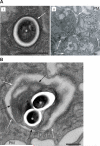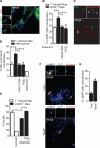Efferocytosis is an innate antibacterial mechanism
- PMID: 22980326
- PMCID: PMC3517204
- DOI: 10.1016/j.chom.2012.06.010
Efferocytosis is an innate antibacterial mechanism
Abstract
Mycobacterium tuberculosis persists within macrophages in an arrested phagosome and depends upon necrosis to elude immunity and disseminate. Although apoptosis of M. tuberculosis-infected macrophages is associated with reduced bacterial growth, the bacteria are relatively resistant to other forms of death, leaving the mechanism underlying this observation unresolved. We find that after apoptosis, M. tuberculosis-infected macrophages are rapidly taken up by uninfected macrophages through efferocytosis, a dedicated apoptotic cell engulfment process. Efferocytosis of M. tuberculosis sequestered within an apoptotic macrophage further compartmentalizes the bacterium and delivers it along with the apoptotic cell debris to the lysosomal compartment. M. tuberculosis is killed only after efferocytosis, indicating that apoptosis itself is not intrinsically bactericidal but requires subsequent phagocytic uptake and lysosomal fusion of the apoptotic body harboring the bacterium. While efferocytosis is recognized as a constitutive housekeeping function of macrophages, these data indicate that it can also function as an antimicrobial effector mechanism.
Copyright © 2012 Elsevier Inc. All rights reserved.
Figures







Comment in
-
"With a little help from my friends": efferocytosis as an antimicrobial mechanism.Cell Host Microbe. 2012 Sep 13;12(3):261-3. doi: 10.1016/j.chom.2012.08.008. Cell Host Microbe. 2012. PMID: 22980322 Free PMC article.
-
Host response: double trouble for TB.Nat Rev Microbiol. 2012 Nov;10(11):730. doi: 10.1038/nrmicro2908. Nat Rev Microbiol. 2012. PMID: 23070551 No abstract available.
Similar articles
-
Interactions between naïve and infected macrophages reduce Mycobacterium tuberculosis viability.PLoS One. 2011;6(11):e27972. doi: 10.1371/journal.pone.0027972. Epub 2011 Nov 18. PLoS One. 2011. PMID: 22125644 Free PMC article.
-
Encephalitozoon cuniculi takes advantage of efferocytosis to evade the immune response.PLoS One. 2021 Mar 5;16(3):e0247658. doi: 10.1371/journal.pone.0247658. eCollection 2021. PLoS One. 2021. PMID: 33667240 Free PMC article.
-
Requirement for invariant chain in macrophages for Mycobacterium tuberculosis replication and CD1d antigen presentation.Infect Immun. 2011 Aug;79(8):3053-63. doi: 10.1128/IAI.01108-10. Epub 2011 May 16. Infect Immun. 2011. PMID: 21576321 Free PMC article.
-
Dying to live: how the death modality of the infected macrophage affects immunity to tuberculosis.Adv Exp Med Biol. 2013;783:103-20. doi: 10.1007/978-1-4614-6111-1_6. Adv Exp Med Biol. 2013. PMID: 23468106 Free PMC article. Review.
-
Evasion of innate immunity by Mycobacterium tuberculosis: is death an exit strategy?Nat Rev Microbiol. 2010 Sep;8(9):668-74. doi: 10.1038/nrmicro2387. Epub 2010 Aug 2. Nat Rev Microbiol. 2010. PMID: 20676146 Free PMC article. Review.
Cited by
-
The Interplay Between Systemic Inflammation, Oxidative Stress, and Tissue Remodeling in Tuberculosis.Antioxid Redox Signal. 2021 Feb 20;34(6):471-485. doi: 10.1089/ars.2020.8124. Epub 2020 Jun 19. Antioxid Redox Signal. 2021. PMID: 32559410 Free PMC article. Review.
-
Macrophages in tuberculosis: friend or foe.Semin Immunopathol. 2013 Sep;35(5):563-83. doi: 10.1007/s00281-013-0388-2. Epub 2013 Jul 18. Semin Immunopathol. 2013. PMID: 23864058 Free PMC article. Review.
-
A Functional Role for Antibodies in Tuberculosis.Cell. 2016 Oct 6;167(2):433-443.e14. doi: 10.1016/j.cell.2016.08.072. Epub 2016 Sep 22. Cell. 2016. PMID: 27667685 Free PMC article.
-
Efferocytosis in health and disease.Nat Rev Immunol. 2020 Apr;20(4):254-267. doi: 10.1038/s41577-019-0240-6. Epub 2019 Dec 10. Nat Rev Immunol. 2020. PMID: 31822793 Free PMC article. Review.
-
Robust IgM responses following intravenous vaccination with Bacille Calmette-Guérin associate with prevention of Mycobacterium tuberculosis infection in macaques.Nat Immunol. 2021 Dec;22(12):1515-1523. doi: 10.1038/s41590-021-01066-1. Epub 2021 Nov 22. Nat Immunol. 2021. PMID: 34811542 Free PMC article.
References
-
- Aronoff DM, Canetti C, Peters-Golden M. Prostaglandin E2 inhibits alveolar macrophage phagocytosis through an E-prostanoid 2 receptor-mediated increase in intracellular cyclic AMP. J Immunol. 2004;173:559–565. - PubMed
Publication types
MeSH terms
Grants and funding
- DP2-0D001378/DP/NCCDPHP CDC HHS/United States
- R56 AI084161/AI/NIAID NIH HHS/United States
- R01AI072143/AI/NIAID NIH HHS/United States
- R56AI084161/AI/NIAID NIH HHS/United States
- UL1 RR029882/RR/NCRR NIH HHS/United States
- TL1 RR029881/RR/NCRR NIH HHS/United States
- T32-AI07387/AI/NIAID NIH HHS/United States
- P30 AI060354/AI/NIAID NIH HHS/United States
- 5P30AI060354/AI/NIAID NIH HHS/United States
- R01 AI098637/AI/NIAID NIH HHS/United States
- T32 AI007387/AI/NIAID NIH HHS/United States
- R01 AI072143/AI/NIAID NIH HHS/United States
LinkOut - more resources
Full Text Sources
Other Literature Sources

